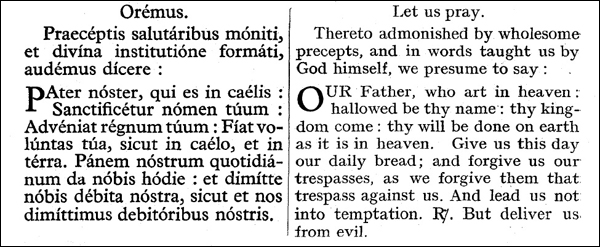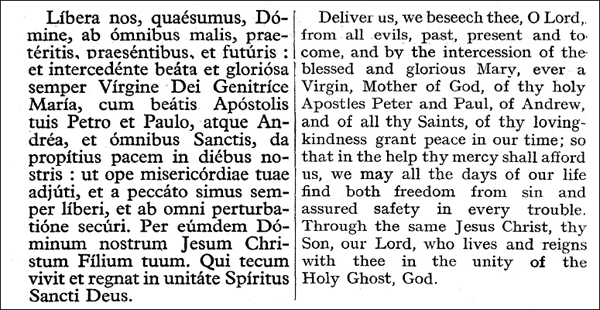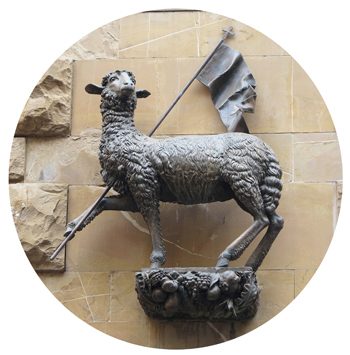About the Church
 |
 |
 |
 |
 |
 |
 |
The Holy Mass - Part XIV
Mass of the Faithful:
From the Lord’s Prayer to the Agnus Dei
As the Preface forms the introduction to the Canon, so does the Pater noster begin the next part of the Mass, the Communion.
Dom Guéranger points out that in all past ages, the Lord's Prayer has had a place in the Mass – in every liturgy and in every Canon of the Mass. (1) And so, raising his voice, with hands uplifted, the priest recites the Pater noster, preceded by the magnificent words Praeceptis salutaribus moniti, which remind us that Holy Church is obeying the precept given by Our Lord himself when He taught us how to pray: "Thus therefore shall you pray: Our Father who art in heaven" (Mt. 6:9).

Liber nos quaesumus & the fractioning of the Host
Holding the paten in his right hand, the priest now beseeches God the Father in a low voice to deliver him and all who pray with him from all evils, past, present and future, through the intercession of the Blessed Virgin Mary and the Saints, and to grant them peace.
Toward the middle of this prayer, when the priest is saying et omnibus Sanctis, he makes the Sign of the Cross with the paten he holds and kisses it, as a mark of honor to the sacred vessel on which the Body of Our Lord is to repose.

As the prayer comes to a close, the priest places the paten under the Host, removes the palia from the chalice, takes the Host and holding it over the chalice, breaks it in half, while saying the words Per eumdem Dominum nostrum Jesum Christum Filium tuum.
 This he does in remembrance of Christ, Who broke bread at the Last Supper.
This he does in remembrance of Christ, Who broke bread at the Last Supper.
As he says the final words of the prayer, he places the part of the Host that is in his right hand on the paten, and breaks off a particle of the other half that he holds in his left hand. The larger piece he places also on the paten, and holding the small particle over the chalice, he says in a loud voice, qui tecum vivit et regnat in unitate Spiritus Sancti Deus.
Then, he takes that particle, makes the sign of the cross three times over the Chalice saying the words Pax Domini sit semper vobiscum, with the server responding, Et cum spiritu tuo. Here he drops the particle of the Host into the Chalice, saying the words Haec commixtio...
Haec commixtio
Just as the separation of the two species is significant of Our Lord's death, so the reunion of His Body and Blood in this ancient rite is intended to remind us of His Resurrection, when His Blood was reunited to His Body.
Dom Guéranger tells us: "It would not have sufficed if His soul alone had been reunited to His Body. His Blood must necessarily be so likewise, in order that the Lord might be whole and complete. Our Savior, therefore, when rising took back His Blood, which was spilled on Calvary, in the Praetorium and in the Garden of Olives." (2)

In her book The City of God, Ven. Mary of Agreda relates that all the Blood shed by Our Lord Jesus Christ during his sorrowful Passion, at the command of His Blessed Mother, was reverently gathered up by the Angels exactly for this purpose, to be reunited with His Body at His Resurrection.
Thus, in the prayer of co-mingling the word consecratio is not taken in the sense of sacramental consecration, but as signifying the reuniting of sacred things.
The Agnus Dei
Until now the prayers said by the priest have been addressed to God the Father. He now calls upon Christ our Redeemer, striking his breast and saying three times the Agnus Dei. These are the very words spoken by St. John the Baptist when he proclaimed to the Jews the Messiah who was living among them and would save them.

At the third time of repetition, the words, dona nobis pacem, are substituted as the conclusion, for the Holy Eucharist is, indeed, the Sacrament of peace, by means of which all the Catholic faithful are united together.
Thus, the Church has always instructed that only Catholics who follow the precepts of the Church and are in the state of grace should approach the altar to receive the Sacred Host. This is the true sense of the communion that is to follow.
At High Mass the kiss of peace is here exchanged between the celebrant and those among the clergy who may be assisting at the altar.
The true Lamb of God
In this article, it is interesting to note that we learn from Holy Scripture and the lives of the Apostles that they were in the habit of saying Mass. Tradition relates of St. Andrew who , when standing before the judge, proclaimed: "I offer daily to the Almighty God upon the altar not the flesh of oxen or the blood of goats, but the spotless Lamb of God (Agnus Dei)." (3)
 For the Jewish synagogue the sacrifice of reparation was made by the sprinkling of the blood of calves and goats. But the Catholic Church, under the New Covenant, which replaced the Old, the sacrifice of reparation is made by offering to the Father the Blood of the Lamb of God.
For the Jewish synagogue the sacrifice of reparation was made by the sprinkling of the blood of calves and goats. But the Catholic Church, under the New Covenant, which replaced the Old, the sacrifice of reparation is made by offering to the Father the Blood of the Lamb of God.
St. Paul makes this holy injunction: "Let us go, therefore, with confidence to the throne of grace; that we may obtain mercy, and find grace in seasonable aid" (Heb 4:16.) What is the throne of grace which the Apostle exhorts us to approach? In his book on the Holy Mass, Fr. Cochem explains:
"It is none other except the sacred altar upon which the Lamb of God is immolated, upon which He gives His life for us, so that we may find grace and mercy. We ought to go as often as we can to this throne of grace to implore help in our necessity. We ought to go with devotion, reverence and confidence, for it is a throne of grace, not of vengeance; a throne of mercy, not of justice; a throne where we shall find aid and shall meet with no rebuff." (4)
Continued

Dom Guéranger points out that in all past ages, the Lord's Prayer has had a place in the Mass – in every liturgy and in every Canon of the Mass. (1) And so, raising his voice, with hands uplifted, the priest recites the Pater noster, preceded by the magnificent words Praeceptis salutaribus moniti, which remind us that Holy Church is obeying the precept given by Our Lord himself when He taught us how to pray: "Thus therefore shall you pray: Our Father who art in heaven" (Mt. 6:9).

Liber nos quaesumus & the fractioning of the Host
Holding the paten in his right hand, the priest now beseeches God the Father in a low voice to deliver him and all who pray with him from all evils, past, present and future, through the intercession of the Blessed Virgin Mary and the Saints, and to grant them peace.
Toward the middle of this prayer, when the priest is saying et omnibus Sanctis, he makes the Sign of the Cross with the paten he holds and kisses it, as a mark of honor to the sacred vessel on which the Body of Our Lord is to repose.

As the prayer comes to a close, the priest places the paten under the Host, removes the palia from the chalice, takes the Host and holding it over the chalice, breaks it in half, while saying the words Per eumdem Dominum nostrum Jesum Christum Filium tuum.

A medieval manuscript representing Christ as truly present on the altar
As he says the final words of the prayer, he places the part of the Host that is in his right hand on the paten, and breaks off a particle of the other half that he holds in his left hand. The larger piece he places also on the paten, and holding the small particle over the chalice, he says in a loud voice, qui tecum vivit et regnat in unitate Spiritus Sancti Deus.
Then, he takes that particle, makes the sign of the cross three times over the Chalice saying the words Pax Domini sit semper vobiscum, with the server responding, Et cum spiritu tuo. Here he drops the particle of the Host into the Chalice, saying the words Haec commixtio...
Haec commixtio
Just as the separation of the two species is significant of Our Lord's death, so the reunion of His Body and Blood in this ancient rite is intended to remind us of His Resurrection, when His Blood was reunited to His Body.
Dom Guéranger tells us: "It would not have sufficed if His soul alone had been reunited to His Body. His Blood must necessarily be so likewise, in order that the Lord might be whole and complete. Our Savior, therefore, when rising took back His Blood, which was spilled on Calvary, in the Praetorium and in the Garden of Olives." (2)

In her book The City of God, Ven. Mary of Agreda relates that all the Blood shed by Our Lord Jesus Christ during his sorrowful Passion, at the command of His Blessed Mother, was reverently gathered up by the Angels exactly for this purpose, to be reunited with His Body at His Resurrection.
Thus, in the prayer of co-mingling the word consecratio is not taken in the sense of sacramental consecration, but as signifying the reuniting of sacred things.
The Agnus Dei
Until now the prayers said by the priest have been addressed to God the Father. He now calls upon Christ our Redeemer, striking his breast and saying three times the Agnus Dei. These are the very words spoken by St. John the Baptist when he proclaimed to the Jews the Messiah who was living among them and would save them.

At the third time of repetition, the words, dona nobis pacem, are substituted as the conclusion, for the Holy Eucharist is, indeed, the Sacrament of peace, by means of which all the Catholic faithful are united together.
Thus, the Church has always instructed that only Catholics who follow the precepts of the Church and are in the state of grace should approach the altar to receive the Sacred Host. This is the true sense of the communion that is to follow.
At High Mass the kiss of peace is here exchanged between the celebrant and those among the clergy who may be assisting at the altar.
The true Lamb of God
In this article, it is interesting to note that we learn from Holy Scripture and the lives of the Apostles that they were in the habit of saying Mass. Tradition relates of St. Andrew who , when standing before the judge, proclaimed: "I offer daily to the Almighty God upon the altar not the flesh of oxen or the blood of goats, but the spotless Lamb of God (Agnus Dei)." (3)

Our Lord is the Lamb of God sacrified on the altar
St. Paul makes this holy injunction: "Let us go, therefore, with confidence to the throne of grace; that we may obtain mercy, and find grace in seasonable aid" (Heb 4:16.) What is the throne of grace which the Apostle exhorts us to approach? In his book on the Holy Mass, Fr. Cochem explains:
"It is none other except the sacred altar upon which the Lamb of God is immolated, upon which He gives His life for us, so that we may find grace and mercy. We ought to go as often as we can to this throne of grace to implore help in our necessity. We ought to go with devotion, reverence and confidence, for it is a throne of grace, not of vengeance; a throne of mercy, not of justice; a throne where we shall find aid and shall meet with no rebuff." (4)
Continued
- Dom Prosper Guéranger, Explanation of the Holy Mass, Loreto Publications, 2007, p. 177.
- Ibid., p. 185
- Martin von Cochem, Explanation of the Holy Sacrifice of the Mass, NY: Benzinger Bros., 1896, p. 19
- Ibid.,p. 185

Posted September 12, 2018














